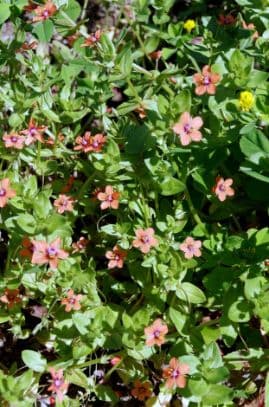Siebold's Primrose Primula sieboldii 'Cherubim' (Co)

ABOUT
The plant 'Cherubim' is a cultivar of Siebold's primrose, recognized for its attractive flowers and foliage. It blooms with intricately patterned blossoms. Each flower of this variety is typically characterized by a soft yet vibrant color palette that can range from white to pastel shades, often with a gradient or a halo towards the center. The center often features a contrasting hue, giving the flowers a striking and eye-catching look. The leaves of 'Cherubim' are notable as well, being lush and forming a low-growing cluster. The foliage is rounded with a slightly toothed edge, and the leaves can have a somewhat wrinkled or textured appearance. During the flowering period, the leaves provide a verdant backdrop to the delicate blossoms, which are borne on slender stalks that rise above the foliage, presenting the flowers in a charming, floating display. Overall, the plant has a clumping habit that creates an appealing mound of green from which the floral display emerges, lending itself to being a focal point in gardens and container plantings. Its ornamental value lies in its beautiful flowers and its capacity to bring a touch of elegance to the spaces it inhabits.
About this plant
 Names
NamesFamily
Primulaceae.
Synonyms
Siebold's Primrose, Japanese Primrose, Cherry Blossom Primrose.
Common names
Primula sieboldii 'Cherubim' (Co).
 Toxicity
ToxicityTo humans
The plant in question, Japanese primrose, is generally considered not toxic to humans. Therefore, if ingested, it is not typically expected to cause poisoning or adverse health effects. However, as with any plant, individual sensitivities can occur, and it is always best to avoid eating plants that are not commonly known to be edible.
To pets
The Japanese primrose is also generally considered to be non-toxic to pets. It is not expected to cause poisoning if ingested by animals such as cats and dogs. Nonetheless, ingestion of any plant material can potentially cause mild stomach upset in some pets due to individual sensitivities or the mechanical irritation of plant matter in the digestive system.
 Characteristics
CharacteristicsLife cycle
Perennials
Foliage type
Deciduous
Color of leaves
Green
Flower color
Pink
Height
6-8 inches (15-20 cm)
Spread
6-8 inches (15-20 cm)
Plant type
Herb
Hardiness zones
5
Native area
Japan
Benefits
 General Benefits
General Benefits- Aesthetic Appeal: Adds vibrant color and delicate beauty to gardens with its attractive blooms.
- Pollinator Attraction: Draws in beneficial insects like bees and butterflies, promoting pollination.
- Ease of Care: Known for being low-maintenance, requiring minimal care once established.
- Cold Tolerance: Hardy in cooler climates, making it suitable for a range of garden zones.
- Seasonal Interest: Provides a splash of color in spring when many other plants have yet to bloom.
- Variety: Comes in several cultivars with different patterns and colors, offering choices for garden design.
- Ground Cover: Can be used to fill in bare spots in the garden, serving as an attractive ground cover.
- Companion Planting: Pairs well with other shade-loving plants, enhancing overall garden aesthetics.
 Medical Properties
Medical PropertiesThis plant is not used for medical purposes.
 Air-purifying Qualities
Air-purifying QualitiesThis plant is not specifically known for air purifying qualities.
 Other Uses
Other Uses- Artistic Inspiration: Primula sieboldii 'Cherubim' can serve as a beautiful subject for paintings, drawings, and other forms of art due to its delicate and vibrant flowers.
- Photography Prop: The distinctive blooms of this primula make it a sought-after object for photographers, particularly for macro photography.
- Culinary Garnish: The flowers of Primula sieboldii 'Cherubim' are edible and can be used to add a splash of color and mild flavor to salads and desserts.
- Teaching Tool: Educators may use this plant to teach botany students about species variety and plant reproduction due to its unique breeding system.
- Eco-Friendly Confetti: Dried petals of Primula sieboldii 'Cherubim' can be used as a biodegradable confetti alternative for celebrations.
- Flower Pressing: The blossoms are suitable for flower pressing, which can be used to create bookmarks, cards, or other craft items.
- Dye Source: The plant's flowers can be used as a natural dye source for fabrics, giving textiles a soft pink hue.
- Literary Motif: Due to its aesthetic appeal, the plant can be referenced in poetry and literature as a symbol of beauty or spring.
- Fragrance Extraction: While not commonly known for its scent, the gentle fragrance can be extracted and used in homemade perfumes or potpourris.
- Butterfly Garden Inclusion: Primula sieboldii 'Cherubim' can be used in butterfly gardens to attract and support local butterfly populations.
Interesting Facts
 Feng Shui
Feng ShuiThe Japanese Primrose is not used in Feng Shui practice.
 Zodiac Sign Compitability
Zodiac Sign CompitabilityThe Japanese Primrose is not used in astrology practice.
 Plant Symbolism
Plant Symbolism- Delicate Beauty: With its dainty blossoms, Primula sieboldii 'Cherubim' often symbolizes a gentle and understated beauty.
- Love and Romance: As a variety of primrose, which is typically associated with love and romance, this plant can represent the tenderness and affection one person feels for another.
- Hope and Renewal: Blooming in the early spring, it represents hope and the renewal that comes with the changing of seasons.
- Youthful Innocence: The 'Cherubim' variety, akin to its name referencing youthful angels, evokes a sense of purity and innocence.
- Eternal Existence: In accordance with some cultures that view the primrose as a symbol of immortality, this variety may embody the notion of an unending life or everlasting love.
 Water
WaterThe Siebold's primrose should be watered thoroughly, allowing the top inch of soil to dry out between waterings. This might equate to adding water approximately once a week, but frequency can vary with environmental conditions. Generally, during active growth in spring and summer, roughly one quart of water per plant every week should suffice. During the winter, water sparingly, just enough to prevent the soil from completely drying out.
 Light
LightSiebold's primrose thrives best in bright, indirect light. It should be placed in a location that avoids the intense, direct sunlight of midday, as this can scorch the leaves. An east-facing or north-facing windowsill is ideal for providing the gentle light that Siebold's primrose prefers.
 Temperature
TemperatureFor Siebold's primrose, the ideal temperature range is between 50°F and 70°F, but it can tolerate temperatures as low as 30°F and as high as 80°F for short periods. Avoid exposing the plant to temperatures outside this range for prolonged durations to prevent stress and damage.
 Pruning
PruningSiebold's primrose benefits from light pruning to remove faded flowers and dead leaves, which encourages new growth and maintains a neat appearance. This can be done anytime spent blossoms are present, but heavy pruning should be avoided. The best time for a more thorough clean-up is after flowering, typically in late spring.
 Cleaning
CleaningAs needed
 Soil
SoilThe best soil for Japanese Primrose 'Cherubim' is well-draining, humus-rich, and consistently moist. A mix of loam, peat, and perlite or sand can create the ideal environment for this primula. It prefers slightly acidic to neutral pH, ranging from 6.0 to 7.0.
 Repotting
RepottingJapanese Primrose 'Cherubim' should be repotted every 1-2 years to replenish the soil and encourage healthy growth. Check the root systems annually in early spring and repot if they appear crowded.
 Humidity & Misting
Humidity & MistingJapanese Primrose 'Cherubim' thrives best in high humidity conditions, ideally between 50% to 70%. Consistent humidity is important for this plant, but avoid waterlogging.
 Suitable locations
Suitable locationsIndoor
Place it in bright, indirect light with moist soil.
Outdoor
Plant in dappled shade, moist, rich soil.
Hardiness zone
3-8 USDA
 Life cycle
Life cyclePrimula sieboldii 'Cherubim' (Co), commonly known as Japanese Primrose, begins its life as a seed, which germinates in the cool, moist conditions of early spring. The seed develops into a small rosette of leaves, and as the plant matures, it forms a clump with deeply veined, heart-shaped leaves. Once the plant is established, it sends up flowering stems in late spring to early summer, producing delicate pink to white blossoms with a central yellow eye. After pollination, the flowers develop into capsules containing seeds, which are dispersed by wind, water, or animal activity. The plant enters a dormancy period in late summer to autumn as it dies back to its root system. In the following spring, the cycle restarts as the rootstock sends up new growth, continuing the perennial cycle of the Japanese Primrose.
 Propogation
PropogationPropogation time
Spring-Early Summer
Propogation: Primula sieboldii 'Cherubim', commonly known as Sakurasou or Japanese Primrose, is most commonly propagated by division. This is best done in late summer to early autumn, as the plant starts to die back naturally. To propagate by division, carefully dig up the entire plant and use a sharp knife or spade to split the clump into smaller sections, ensuring each section has a portion of the root system and some shoots. Replant the divisions at the same soil depth they were growing before and water them well to help establish roots. It's essential to maintain consistent moisture while the new divisions are establishing themselves in their new locations, which can take several weeks.









